Papers by Jérôme Juilleret

The Weierbach experimental catchment (0.45 km<sup>2</sup>) is the most instrumented a... more The Weierbach experimental catchment (0.45 km<sup>2</sup>) is the most instrumented and studied sub-catchment in the Alzette River basin in Luxembourg. Within the last decade, it has matured towards an interdisciplinary critical zone observatory focusing on a better understanding of hydrological and hydro-geochemical processes. Since 2009, the Weierbach has been extensively equipped for continuously monitoring water fluxes and physico-chemical parameters within different compartments of the critical zone. Additionally, these compartments are sampled fortnightly at several locations to analyze d<sup>18</sup>O and d<sup>2</sup>H isotopic composition of water including rainfall, throughfall, soil water, groundwater and streamwater. This link provide the entire database acquired from 2009 to 2019 for hydro-climatological parameters and water isotopic composition. This repository contains a summary table containing site and monitoring meta data (<st...
We need your help to fully understand how scientists from different backgrounds define the terms ... more We need your help to fully understand how scientists from different backgrounds define the terms “colluvium” and “alluvium.” We ask that you contribute your perspective by taking the survey at http://goo.gl/forms/ f V8RBWKjis. The closing deadline is October 31, 2016. The feedback so far has been positive, and many participants have described the experience as fun. Many commented on how the survey challenged their thinking about these sediments, causing them to more carefully consider potential gaps in their definitions for the terms and their strategies for identifying the materials. Others have expressed great interest in the results because they too have sometimes struggled with how to best use these terms. The following background describes why we are pursuing the question of how scientists are using the terms colluvium and alluvium.
Hydrology and Earth System Sciences, 2021
Hydrological Processes, 2021
The Weierbach experimental catchment (0.45 km 2) is the most instrumented and studied sub-catchme... more The Weierbach experimental catchment (0.45 km 2) is the most instrumented and studied sub-catchment in the Alzette River basin in Luxembourg. Within the last decade, it has matured towards an interdisciplinary critical zone observatory focusing on a better understanding of hydrological and hydro-geochemical processes. The Weierbach catchment is embedded in an elevated sub-horizontal plateau, characterized by slate bedrock and representative of the Ardennes Massif. Its climate is semimarine, with precipitation being rather evenly distributed throughout the year. Base

Earth-Science Reviews, 2020
Abstract In the history of alluvium and colluvium, the definitions have been shifted and rearrang... more Abstract In the history of alluvium and colluvium, the definitions have been shifted and rearranged several times, and this evolution is ongoing. Although field books, textbooks, and dictionaries provide standardized references, the authors of those definitions must wrestle with a wide variety of previous definitions, especially for colluvium. Contributing to this challenge is the need for Earth scientists to match available terminology to fit specific cases, which has resulting in the stretching of definitions to the point of overlap and sometimes contradiction. Alluvium was first used to describe gradual and imperceptible deposition of new earth material along rivers by floods. In the 19th century, as coarse, alluvium-like sediment in higher landscape positions was unlikely deposited by annual flooding, geologists explained those “older alluvium” deposits by the biblical deluge and named such materials diluvium. Although not the original definition, cases where alluvium and diluvium could not be distinguished, were named colluvium. Later, colluvial soils replaced ‘overplacement soils’ to describe regolith that had been transported down slope by mass-gravity processes. Concurrently other scientists used colluvium to describe deposits from slope wash. Modern definitions tend to connect to one, or more frequently both, of those concepts. The resulting spectrum of definitions presents the potential for confusion and miscommunication. This pattern was observed in a survey of 376 Earth scientists who generally agreed with defining colluvium as produced by mass-gravity-driven transport on steep slopes and alluvium as produced by water-driven transport on floodplains. However, diverse perspectives were evident for the spectrum between those two end members. This paper synthesizes the history, the logic, current perspectives, and potential strategies going forward.

Facies, 2020
Fossil bioerosion traces at a new site of Les Bez (Jura Department) and those already known from ... more Fossil bioerosion traces at a new site of Les Bez (Jura Department) and those already known from Verrières-de-Joux (Doubs Department) in the central French Jura record an ancient Miocene cliffed shoreline cut into Lower Cretaceous limestones. Both localities are at about 900 m above the present sea level. Caulostrepsis, Gastrochaenolites and Circolites are the ichnogenera identified at Les Bez, whereas only Gastrochaenolites is present at Verrières-de-Joux. This ichnoassociation identifies the Entobia ichnofacies, which corresponds to the upper infralittoral marine environment, biologically associated with the biocenosis of photophilic algae. By means of digital analysis of high-resolution field images, the percentage of the surface affected by the erosive activity of polychaete worms, bivalves and echinoids has been calculated. This information permits a better evaluation of their biological activity, thus complementing the data on the number of specimens per surface area. The cliff preserved at Les Bez was more affected, showing Gastrochaenolites with diameters smaller than those at Verrières. The Circolites–Caulostrepsis association is well developed at Les Bez, where polychaete borings are located within echinoid bowl-shaped pits with particular patterns, suggesting an ecological relationship between involved organisms. Moreover, the distribution of the borings along this outcrop is not uniform and digital analysis at three sections (A, B and C) suggests a lower and an upper zone developed on the outcrop under slightly different environmental conditions within the upper infralittoral. The exceptional preservation of the Les Bez fossil cliff-site demands protection in order to ensure its future existence and accessibility.
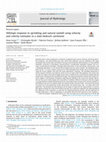
Journal of Hydrology, 2018
Subsurface flow is often recognized as a dominant runoff generation process. However, observing s... more Subsurface flow is often recognized as a dominant runoff generation process. However, observing subsurface properties, and understanding how they control flow pathways, remains challenging. This paper investigates how surface slope and bedrock cleavage control subsurface flow pathways in a slate bedrock headwater catchment in Luxembourg, characterised by a double-peak streamflow response. We use a range of experimental techniques, including field observations of soil and bedrock characteristics, and a sprinkling experiment at a site located 40 m upslope from the stream channel. The sprinkling experiment uses Br À as a tracer, which is measured at a well downslope from the plot and at various locations along the stream, together with well and stream hydrometric responses. The sprinkling experiment is used to estimate velocities and celerities, which in turn are used to infer flow pathways. Our results indicate that the single or first peak of double-peak events is rainfall-driven (controlled by rainfall) while the second peak is storage-driven (controlled by storage). The comparison between velocity and celerity estimates suggests a fast flowpath component connecting the hillslope to the stream, but velocity information was too scarce to fully support such a hypothesis. In addition, different estimates of celerities suggest a seasonal influence of both rainfall intensity rate and residual water storage on the celerity responses at the hillslope scale. At the catchment outlet, the estimated of the total mass of Br À recovered in the stream was about 2.5% of the application. Further downstream, the estimate mass of Br À was about 4.0% of the application. This demonstrates that flowpaths do not appear to align with the slope gradient. In contrast, they appear to follow the strike of the bedrock cleavage. Our results have expanded our understanding of the importance of the subsurface, in particular the underlying bedrock systems, and the importance of cleavage orientation, as well as topography, in controlling subsurface flow direction in this catchment.
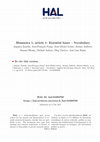
Applied Soil Ecology, 2018
The Special Issue Humusica 1 corresponds to a field guide for the classification of terrestrial h... more The Special Issue Humusica 1 corresponds to a field guide for the classification of terrestrial humus systems and forms. The present first article of the issue defines vocabulary, objects and concepts necessary for: (a) field investigation, (b) understanding the process of classification, (c) assigning ecological significance to the defined morpho-functional units, (d) discussing and exchanging scientific data about humus systems. The article starts with general considerations, as the necessity humans have to classify natural objects for sharing ideas and information on them. Then the article focuses on soil as functional element of every ecosystem. Historical and recently published international definitions of soil are reported and compared to the more biological definition of the authors of the paper. Once the concept "soil" is clarified, the soil profile is shared in three new subunits, for further specialised investigations. The superficial and organic-rich sub-unit is labelled Humipedon. In the rest of the article, authors explain the different constituents of a general humipedon, introducing even novice soil scientists to field practice and topsoil observation. A general overview of the variety of humipedons that one may expect to find all over planet Earth, classified in humus systems and forms, concludes the article.
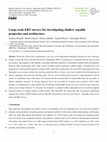
Hydrology and Earth System Sciences Discussions, 2018
Within the Critical Zone, regolith plays a key role in the fundamental hydrological function of w... more Within the Critical Zone, regolith plays a key role in the fundamental hydrological function of water collection, storage, mixing and release. Electrical Resistivity Tomography (ERT) is recognized as a remarkable tool for characterizing the geometry and properties of the regolith, overcoming limitations inherent to conventional borehole-based investigations. However, ERT measurements with a high vertical resolution remain restricted to shallow depths, essentially due to the requirement of small electrode spacing increments (ESI). Under these circumstances, the use of ERT measurements for large horizontal surveys remains cumbersome and time-consuming. Here we focus on the need to optimize the ESI parameter in order to adequately characterize the subsurface fabric. We use a set of synthetic three-layered soil-saprock/saprolite-bedrock models in combination with a field dataset. We demonstrate that oversized ESI can significantly affect our perception of shallow subsurface structures by missing important layers and increasing the ill-posed inverse problem effects. More precisely, we document how a thin surficial layer can influence inverted ERT results and cause a resistivity bias, both at the surface and at deeper horizons. To overcome this limitation, we propose adding interpolated levels of surficial apparent resistivity based on a limited number of ERT profiles with small ESI. We demonstrate that our protocol significantly improves the accuracy of ERT profiles based on large ESI. Our protocol is time and cost efficientespecially in the case of large-scale ERT surveys. 1 Introduction The architecture and properties of regolith, as well as its distribution across the landscape, play a key role in how rainfall is collected, stored and finally released to generate and shape streamflow in Critical Zone studies (Schoeneberger and Wysocki,
Applied Soil Ecology, 2017
article 4 is strongly related to Humusica 1, article 8, where a lot of photographs illustrate ped... more article 4 is strongly related to Humusica 1, article 8, where a lot of photographs illustrate pedofauna and associated droppings. The presented terms and diagnostic horizons are conceived for understanding the soil functioning. They allow to classify the soil with the morpho-functional key illustrated in Humusica 1, article 5. † Corresponding author.
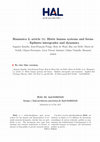
Applied Soil Ecology, 2017
The processes of formation and evolution of Histic humipedons are related to the soil/water dynam... more The processes of formation and evolution of Histic humipedons are related to the soil/water dynamics. In a first part of the paper we present diagnostic features and horizons necessary for describing the intergrade humipedons existing between Histic and Hydro humipedons. Called Epihistic ("superficial" Histic), these humipedons are very common and help in better defining the relationships between plant and soil in semi-terrestrial environments. In a second part of the paper we set some information about biological activities and correlated environmental frames of Histic and Epihisto units. The article concludes with dynamic relationships between humipedons, describing them in fen or bog ecosystems, allowing the interpretation of complex wetlands. The present manuscript updates the description and classification of semi-terrestrial humus forms previously published by Zanella et al. (2011a, 2011b).

Journal of Hydrology, 2016
Double peak hydrographs are widespread phenomena but poorly understood mechanistically. In many c... more Double peak hydrographs are widespread phenomena but poorly understood mechanistically. In many cases, saturation-excess overland flow in the near-stream areas is assumed to control the initial peak, while the delayed peak is explained by subsurface flow in the soil or sediment cover or groundwater flow on fractured bedrock. Here we explore the mechanisms that control the generation of double peak hydrographs in a forested headwater catchment. We made use of the extensive high-resolution hydrometric time series collected in the catchment to estimate catchment storage and causal linkages. We found that double peak hydrographs occurred only after a certain amount of catchment storage was exceeded. The amount of this storage threshold was consistent over a 3-year period. The nonlinear relationship between storage and discharge led to hysteretic relationships between both variables, and these hysteretic relationships were different for the different hydrograph types (single or double peak hydrographs). Discharge peaked before catchment storage during single peak hydrographs suggesting that single peaks were mainly generated by water quickly reaching the stream during precipitation pulses. It was catchment storage that peaked first during double peak hydrographs and consequently generated the delayed peak in the hydrograph. Our results also showed that double peak hydrographs were controlled in different proportions by contrasting landscape units (defined along a hillslope sequence). Hillslopes were connected to the stream at low discharge values, whereas the plateau dominated discharge generation when storage reached a certain threshold value.

Geoderma, 2016
Abstract As soil surveys were traditionally conducted in support of agriculture, soil classificat... more Abstract As soil surveys were traditionally conducted in support of agriculture, soil classification tended to focus on upper soil horizons and their characteristics. However, when dealing with environmental issues – such as vegetation ecology or water quality – an integrated knowledge of the soil, soil-to-substratum, and deeper substratum continuum is required. In both World Reference Base for soil resources (WRB) and Soil Taxonomy (ST), the lower boundary for soil classification is arbitrarily set at 2 m, including weathered and continuous rock. However, as soil classification hinges on diagnostic horizons and characteristics, which often occur within the first 100 cm, collecting data on the subsolum is often neglected. We propose a classification system of the subsolum , the structure of which is inspired by WRB. We define Regolite , Saprolite , Saprock and Bedrock as four subsolum reference groups corresponding to different weathering stages. Intergrades of these reference groups can be qualified with principal qualifiers, while morphologic and lithologic characteristics can be presented with supplementary qualifiers. The proposed subsolum classification system is not intended to substitute geological surveys, but rather to complement existing soil classification systems such that at least the whole 2 m can be categorized. Still, whenever desired the system can also be used for deeper materials.
Ecohydrology, 2015
ABSTRACT
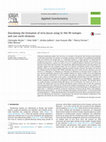
Applied Geochemistry, 2015
Carbonate weathering mantles, like terra fusca, are common in Europe but their formation and evol... more Carbonate weathering mantles, like terra fusca, are common in Europe but their formation and evolution is still badly understood. We propose to combine geological, mineralogical and pedological knowledge with trace element and isotope data of a weathering mantle as a novel approach to understand the evolution of terra fuscas. Sr-Nd-Pb isotopes and rare earth element (REE) contents were analyzed in a cambisol developing on a typical terra fusca on top of a condensed Bajocian limestone-marl succession from the eastern side of the Paris Basin. The isotope data, REE distribution patterns and mass balance calculations suggest that the cambisol mirrors the trace element enrichments present in this carbonate lithology, which are exceptionally high compared to global average carbonate. The deeper soil horizons are strongly enriched not only in REE (RREE: 2640 ppm) but also in redox-sensitive elements such as Fe (44 wt.%), V (1000 ppm), Cr (700 ppm), Zn (550 ppm), As (260 ppm), Co (45 ppm) and Cd (2.4 ppm). The trace element distribution patterns of the carbonate bedrock are similar to those of the soil suggesting their close genetic relationships. Sr-Nd-Pb isotope data allow to identify four principal components in the soil: a silicate-rich pool close to the surface, a leachable REE enriched pool at the bottom of the soil profile, the limestone on which the weathering profile developed and an anthropogenic, atmospherederived component detected in the soil leachates of the uppermost soil horizon. The leachable phases are mainly secondary carbonate-bearing REE phases such as bastnaesite ((X) Ca(CO 3) 2 F) (for X: Ce, La and Nd). The isotope data and trace element distribution patterns indicate that at least four geological and environmental events impacted the chemical and isotopical compositions of the soil system: 1. An oxygen-deficient diagenetic or hydrothermal event caused trace metal enrichments in the Bajocian limestone-marls. 2. Carbonate dissolution caused the enrichment of detrital silicate phases and authigenic REE-bearing residual phases-e.g. marine authigenic fluorapatites and bastnaesite-in the newly formed condensed horizons. 3. Dissolution/precipitation of metastable bastnaesite phases and downward migration of the REE during soil formation. 4. Overprinting of the chemical and isotopical compositions of the uppermost soil horizon by recent atmospheric depositions.
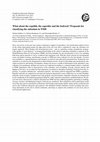
Since soil surveys in the past were mainly conducted in support of agriculture, soil classificati... more Since soil surveys in the past were mainly conducted in support of agriculture, soil classification tended to focuson the solum representing mainly the upper part of the soil cover that is exploited by crops; the subsolum was largely neglected. When dealing with environmental issues - such as vegetation ecology, groundwater recharge,water quality or waste disposal - an integrated knowledge of the solum to subsolum continuum is required. In the World Reference Base for soil resources (WRB), the lower boundary for soil classification is set at 2 m, including both loose parent material as well as weathered and continuous rock. With the raised concern for environmental issues and global warming, classification concepts in WRB have been widened over the last decades. Cryosols were included as a separate Reference Soil Group to account for soils affected by perennial frost; Technosols were included to account for soils dominated by technical human activity. Terms for describing and classi...

The Weierbach catchment is characterized by a unique geological substratum of schist and phyllite... more The Weierbach catchment is characterized by a unique geological substratum of schist and phyllites. The winter streamflow response to a rainfall show two distinct peaks with markedly different time scales (Van den Bos et al., 2006b), whereas the summer response present only the first one. The hydrograph show that the first peak is near concomitant with rainfall. Chemical analyses have suggested that water collected during the two peaks has distinct chemical compositions and is likely to originate in different catchment compartments. Until now, we assumes that the first peak is the result of Saturated Overland Flow or direct runoff over the near-stream riparian zone according to the rise of dissolved organic carbon and the high velocity of reaction of the hydrograph. We hypothesized that the first peak is the result of direct runoff over the near-stream riparian zone according to the rise of dissolved organic carbon and the high velocity of reaction of the hydrograph. The second peak...

ABSTRACT A dense observation network monitoring river discharge in Luxembourg, set up by the publ... more ABSTRACT A dense observation network monitoring river discharge in Luxembourg, set up by the public authorities and the CRP-Gabriel Lippmann, makes it possible to study the hydrological regime of a wide fan of river basins with diff erent geological substrata. We analysed the specifi c discharge of three river basins in Luxembourg during the recession period of the summers 2003 and 2004. The aim was to highlight the infl uence of lithology on specifi c discharge in general, and the role of Luxembourg Sandstone in particular. An analysis of the Master Recession Curve (MRC), which is representative for the long term recession period, shows that: - River basins with the highest specifi c low summer discharge and with the lowest reservoir coeffi cient are those basins of which the outcrop area consists dominantly of Luxembourg Sandstone. - River basins with the lowest specifi c low summer discharge and with the highest reservoir coeffi cient are those basins of which the outcrop area consists dominantly of a marly or schistose lithology. The spatial variability of low discharge is mainly related to the lithology varying with and within river basins. Thus, basins located on the Luxembourg Sandstone outcrop zone are signifi cantly distinguishable. The Luxembourg Sandstone is a permeable rock, capable of storing great quantities of water; it permits a good sustained low discharge in river basins, compared to the low discharges in basins with a dominant marly or schistose lithology. The Luxembourg Sandstone is one of the main subterranean drinking water reservoirs of the Grand Duchy of Luxembourg.





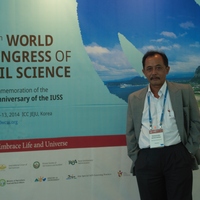




Uploads
Papers by Jérôme Juilleret